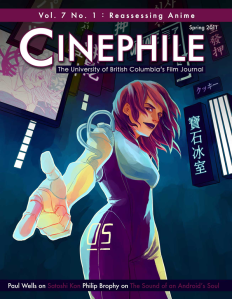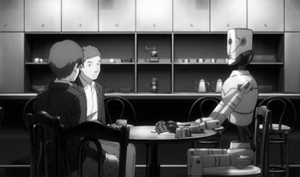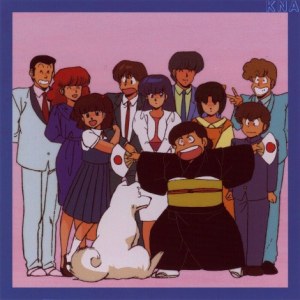We are deep in the cyborg age. Our daily lives are a series of technological and machinic interactions – computers, cars, mobile phones, not to mention prosthetics, pacemakers, life support systems – where we are hooked up and connected to a range of different mediums and circuits: an integration of man and machine. And these exchanges have surpassed the frivolous to the point of dependency – how is a businessman supposed to function without a phone or computer? Bank accounts, weapon systems, information systems – all computerized. With no intention of reliving Y2K paranoia, what would happen if technology was suddenly to fail, or be usurped by some belligerent entity? Chaos. Our society revolves around technology. We are all, in one way or another, cyborgs.
But how does this effect children and youths? What identity issues come to the surface? And in the face of postmodern war, how do cyborg soldiers come into play? These are some of the questions I would like to address through an examination of children and youth as cyborg soldiers – child-machine weapons – through science fiction anime. The anime discussed in terms of child-machine weaponry will include SaiKano (Kase, 2002), Neon Genesis: Evangalion (Anno, 1995-1996), Akira (Otomo, 1988), Mobile Suit Gundam[1], and Metropolis (Rintaro, 2001) (as well as touching on a few other pertinent titles). Through addressing these questions, I will argue that there is a feminisation of technology taking place in these anime. This post will also examine the nature of the cyborg and how it has translated onto anime’s younger characters within the science fiction field. But first, a closer look at Donna Haraway’s cyborg is necessary.
Traditionally, the West has seen technology as essentially masculine, being both cold and mechanical, whereas the feminine has been reserved to the organic and nature: the ‘warmer’ aspects of our world (Marsh & West, 2003: 183-184). However, the cyborg coalesces the organic with the machine, the masculine with the feminine. Donna Haraway’s image of the cyborg denotes a cybernetic organism that embodies both human and machine characteristics and is as much a part of social reality as it is of fiction (Haraway, 2001: 139). It is an entity that problematises dualities such as mind/body, nature/culture, man/woman, primitive/civilised (Loza, 2001: 350) and most obviously, man/machine. Through the cyborg, the man/machine dichotomy is broken down. And once this boundary has been dissolved, all other dualities also collapse, unifying the disparate elements to the point in which they become indistinguishable (Springer in Loza, 2001: 350). Take note of gender binaries and, most importantly for this discussion, dualistic cultural assumptions. ‘The cyborg is a threshold at which the possibilities we have hoped for in the past and those we seek in the future become indistinct; we are all now becoming “hybridized”, “biomatic” and “technocorporeal”’ (Sotirin, 2005: 101). Similarly, as the soldier becomes increasingly cyborgian, their gender identity shifts, often becoming more cyborg than a particular gender (Gray, 2002: 58); they are ‘neither male nor female in any absolute sense’ (Robertson, 2007: 393). For the child-machine weapons, there is a shift from the absolutist, cold, masculine qualities traditionally attributed to technology to a feminisation of technology (that does not completely abolish the masculine element).
Anime scholar Brian Ruh identifies such a trend in Oshii’s first Patlabor film (Oshii, 1989) (Ruh, 2004: 97). The female characters, Noa and Kanuka, are given precedence over the main labor pilot, Ohta, in the film. The climactic end battle is a face off between Noah and a rogue labor, where Noah triumphs, demonstrating an affinity with her machine. Ruh also draws attention to the more feminine look of the prototype patlabor unit as opposed to the bulkier design used by the SV2 team; its main weapon is no longer the phallic gun, but rather an extendable arm that can cut through an opponents armour; and it also proves more agile and effective in combat than the other labor models (Ruh, 2004: 97). Similarly, and more to the point of children as cyborg weapons, Neon Genesis: Evangalion presents high school students (the majority of which are female[2]) in symbiosis with their evas – mecha weapons. Effectively, they must shed their ego-autonomy and corporeal limitations in order to synchronise with their machines (Orbaugh, 2009: 120). And may note the slimmer mecha designs of the Evas and also their brighter colours: a feminised design. Furthermore, Shinji is far from the archetypal male hero, struggling with his masculinity throughout most of the series. The stronger characters (although I am aware that they are all well fucked up in their own ways) are the females. This seems a somewhat refreshing progression from the more dualistic Western approach to technology and gender.
In SaiKano, the female protagonist Chise consents to having her body modified by the military, turning her into a child-machine weapon, female inclined due to her biology but by mixing the organic with the machine – the traditional masculine with the female – we have sporadic moments of gender fluidity. She is a high school student on the cusp of puberty, and really, the whole show can be interpreted as a metaphor for puberty – as perhaps all child-machine anime can. In the show, there is a consistent emphasis on bodily change and development, heightened emotions, and relationships struggling to maintain their childhood innocence. In one episode, Shu-Chan’s (Chise’s boyfriend) classmates mistake Chise’s claim that she is ‘growing’ to mean an increase in breast size. It could also be argued that it is during puberty that girls begin to realise their sexual power, in a sense, their sexual weaponry, working out how to use and control it. It is a turbulent and violent time – blood is spilled, no humour intended – where emotions can strike out like weapons (Akira and Eva are other examples). Chise is a cyborg soldier dynamic in gender identity but with obvious feminine inclinations.
The future into which these cyborg kids are maturing is one that requires an integration with technology, necessary for survival on the battlefield of their pubescent existence, but at what cost? They come face-to-face with the postmodern identity crisis in the technological age. Where do they fit into this information cyberscape? In terms of postmodern war, the military looked to technology to solve their own identity crisis. Dreams of smart weapons and bloodless infowar have been replaced with the new reality of the cyborg soldier (Gray, 2002: 57). And in these anime, the young characters are becoming just this, they are the beating heart, the life force within their technological womb – pubescent emotions turned feral, striking with the force of entire armies. Consider Tetsuo from Akira: a biological weapon in himself, constantly integrating with surrounding technology in mutations beyond his control.
Furthermore, anime scholar Jane Chi Hyun Park has drawn a comparison between Teema from Metropolis and Major Kusanagi[3] from Ghost in the Shell (Oshii, 1995). Park writes that both characters are ‘artificial females who are simultaneously feminine and masculine, strong and vulnerable’ (Park, 2005: 63). They are also both weapons: Teema is the missing piece to the ziggurat, set to be the most powerful weapon in the world, and Kusanagi is a government assassin. Park states that ‘[n]either character performs the male gaze’ and both are androgynous to an extent (Park, 2005: 63). On the one hand, Kusanagi possesses an attractive body, or ‘shell’, but it is not sexualized; in fact, she is a somewhat non-sexual character. On the other hand, Teema is androgynous due to her age, the androgyny of childhood. Both are cyborg beings in futures where technology is no longer seen as an ‘other,’ but something that has converged with our very existence, the organic and the machine as one, masculine and feminine two sides of the same coin, gender fluid and interchangeable.
And in this age of cyborgs weapons, the animes discussed raise a worthwhile question: Does childhood innocence have a place in these posthuman representations of our future? While the cyborg can prove liberating, perhaps for many in terms of gender and organic-machine boundaries, there is also an ethical conflict that seems to be implied through these texts. So, while the cyborg has its positives, the texts discussed seem to suggest an undercurrent of ethical uncertainty for a posthuman future. Despite anime scholar Jennifer Robertson’s belief that due to Japan’s non-monotheistic belief, dualistic thinking is not as embedded in the Japanese mentality (Robertson, 2007: 393), computer scientist Frederic Kaplan concludes that posthuman futures are seldom met with enthusiasm in anime, where a harmonious ‘side-by-side’ coexistence is favoured over more integrated cyborgian becomings (Kaplan, 2004: 3). The anime mentioned support this[4].
So through a feminisation of technology, the child-machine weapons are not abnegating masculinity all together, just moving away from it towards a gender hybridized future, allowing the cyborg to achieve its potential. The weaponry side of things only emphasises this characteristic more, where weapons, suggesting war, are seen as male-dominant areas of society and humanity. It also paints the posthuman in a violent and destructive hue – a corrupter of innocence, the all-consuming machine-monster, abject and transgressive, preys on children’s tears. This only further enforces Kaplan’s point.
As a final observation, the child-machine weapons seem to lack parents. Think of the Gundam children, Chise, Teema and the Eva pilots. They are either without parents, or if they have them, they are either not mentioned or rarely present[5]. Similarly, the cyborg lacks a humanist origin story. By nature, it does not separate itself, and consequently define itself against, a maternal figure. By extension, there is no need for the production of an ‘other’ entity to be overcome and defined against (Schneider, 2005: 63-64). It is not so much pre-Oedipal as it is anti-Oedipal. It does not exist in the transcendental realm of hierarchies and binary systems, and as a result, exists in a more immanent, liminal space in which gender assumptions can be contested and renegotiated. Of course, I am not suggesting that these kids were not born from the womb (although in some instances it may be the case), but in an analytical capacity, the argument could be made that they, as cyborgs, transcend Oedipal existence. In some ways this is liberating, but more so tragic – disturbing reminisces of Huxley’s parentless citizens in A Brave New World (Huxley, 2006), or even Ergo Proxy’s (Murase, 2006) mechanically bred ‘model citizens.’ It becomes a deprivation of our humanity; parents as necessary character-moulding guides to a healthy and organic existence. So the discussion on child-machine weaponry inevitably returns to ethical conflict: the animes seem to be rejecting the tenet of a posthuman existence viewing it as impoverished and ethically problematic. All I can say is at least someone is thinking of the children.
[1] I am only drawing off the Gundam series I have seen recently which are 08th MS Team (Kanda & Iida, 1996) and 0083: Stardust Memory (Kase & Imanishi, 1991).
[2] I understand there are five pilots selected in the original series but two of the males are more temporary than the central three. Therefore, by battle presence and screen time, the female pilots represent the majority.
[3] I am aware Kusanagi is an adult character, but she is interestingly reborn in a child’s body by the end of the film.
[4] With the exception of maybe Ghost in the Shell, but that is open to debate.
[5] Of course, Shinji’s dad is still alive, but for most of the series is absent as a father figure.
 Not surprisingly, it is an academic with a keen interest in otaku community and otaku identity that is the one to tackle the moe phenomenon. Scholar Michael R. Bowman’s very necessary article, “Beyond maids and Meganekko: Examining the Moe Phenomenon” (Bowman, 2011: 14-18), offers some much needed clarity on the concept. Bowman attempts to pin down a definition of what moe actually is, untangling it from the slew of contradictory and sexually-based misconceptions rife in the cyber community. He claims that it is in fact “nonsexual” where any “[s]exual feeling should be seen only as a secondary response that sometimes is coupled with, but is still separate from, the more authentic moe response…” (Bowman, 2011: 15). Furthermore he explores moe as a “longing for fatherhood,” a nurturing, rather than a perverse, lecherous and depraved, response (Bowman, 2011: 16). For Bowman, moe becomes a manifestation of kawaii, a masculine escape from the numbing realities of adulthood in Japan, a prolongation of childhood (Bowman, 2011: 17). Also examined are moe’s origins, expelling myths of it being a modern phenomenon (Bowman, 2011: 16). While Bowman’s article was not what drew me to the journal, it soon revealed itself as the most relevant and important piece in regards to the current anime/otaku climate. I highly recommend it to those with an interest in moe, especially those intending to write about it.
Not surprisingly, it is an academic with a keen interest in otaku community and otaku identity that is the one to tackle the moe phenomenon. Scholar Michael R. Bowman’s very necessary article, “Beyond maids and Meganekko: Examining the Moe Phenomenon” (Bowman, 2011: 14-18), offers some much needed clarity on the concept. Bowman attempts to pin down a definition of what moe actually is, untangling it from the slew of contradictory and sexually-based misconceptions rife in the cyber community. He claims that it is in fact “nonsexual” where any “[s]exual feeling should be seen only as a secondary response that sometimes is coupled with, but is still separate from, the more authentic moe response…” (Bowman, 2011: 15). Furthermore he explores moe as a “longing for fatherhood,” a nurturing, rather than a perverse, lecherous and depraved, response (Bowman, 2011: 16). For Bowman, moe becomes a manifestation of kawaii, a masculine escape from the numbing realities of adulthood in Japan, a prolongation of childhood (Bowman, 2011: 17). Also examined are moe’s origins, expelling myths of it being a modern phenomenon (Bowman, 2011: 16). While Bowman’s article was not what drew me to the journal, it soon revealed itself as the most relevant and important piece in regards to the current anime/otaku climate. I highly recommend it to those with an interest in moe, especially those intending to write about it.

















